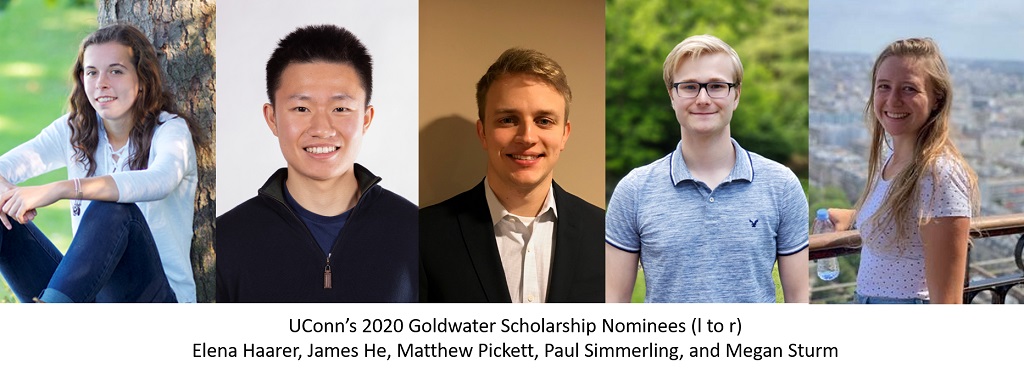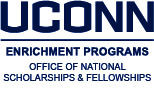The Goldwater Scholarship awards $7,500 to college sophomores and juniors majoring in math, science, engineering, or research psychology (not clinical). Students who are competitive for the award have had significant research experience and have plans for graduate study (aspire to a PhD or MD/PhD) and a career in research.
ONSF is pleased to introduce UConn’s 2020 Goldwater Scholarship nominees.
Elena Haarer (CLAS ‘21) from Syracuse, NY, is an Honors student majoring in Molecular and Cell Biology. She is planning on earning a Ph.D. in Biochemistry and obtaining a position at a leading research institution where she can pursue her passion for both research and teaching. Since the fall of her sophomore year, she has worked in Dr. Kenneth Campellone’s lab in the Institute for Systems Genomics. The focus of her independent research project is to elucidate the actin cytoskeletal functions involved in chromatin dynamics and DNA repair mechanisms and their impact on cellular aging processes. In the fall of 2019, she presented a poster on her research at the Northeastern Glenn Symposium on the Biology of Aging. In the summer following her sophomore year, Elena worked in Dr. Elizabeth Lawlor’s lab in the Pediatric Hematology/Oncology Department at the University of Michigan Medical School. Her project focused on aspects of epigenetic gene regulation and metabolic reprogramming in Ewing sarcoma, an aggressive pediatric bone tumor, with the goal of identifying novel therapeutic targets to eventually treat this rare and debilitating disease. Outside of her research, she is a teaching assistant for an undergraduate Cell Biology course, a musician in the UConn Pep Band, and a member of Alpha Phi Omega, a national service organization, where she participates in volunteer projects to support the surrounding communities. In her free time, Elena is an avid pickleball player and dedicated Tottenham Hotspur fan.
James He (CLAS ’21), from Woodbridge, CT, is a STEM Scholar majoring in Molecular and Cellular Biology and minoring in Mathematics and Neuroscience. He plans to pursue an M.D./Ph.D. upon graduation. Throughout high school, he interned at Haskins Laboratories at Yale University as a part of his school’s Science Research Program, and participated in various science competitions presenting his research on the reading development of young children. The research utilized a number of behavioral metrics to define the reading development of the participants, though he was constantly puzzled by the neurological axis of this work. Combined with his personal experiences with cancer patients, this led to his pursuit of research in Dr. LoTurco’s lab in the Physiology and Neurobiology Department. Since his freshman year, he has been involved in an investigation of the mechanisms of tumorigenesis of a subtype of ependymoma, a tumor of the central nervous system. For his freshman Holster Scholars project, he investigated the role of two upregulated transcription factors, LHX2 and LMX1B, in the development of ependymoma tumors in a mouse model, and has continued to probe deeper into their tumorigenic properties through the SURF program this past summer and his current University Scholar project. Lately, he has been utilizing single-cell RNA-sequencing and CRISPR/Cas9 technology to understand the precise conditions and mechanisms that result in the formation of ependymoma tumors. Accompanying his interest in research and medicine, he is a passionate violinist, and is a member of the university’s symphony orchestra. James is the America Reads Preschools Site Manager and the Director of Programming for the Kidney Disease Screening Awareness and Prevention Program. Aside from his academic pursuits, he is a huge fan of soccer and basketball, and loves to compete in the intramural leagues.
Matthew Pickett (CLAS ‘21) from Canton, CT is a junior majoring in Chemistry and minoring in Mathematics. He plans to pursue a Ph.D. in Chemistry with a focus in inorganic chemistry—specifically the use of inorganic chemistry techniques to solve environmental problems. After two years at Boston College, Matthew transferred to the University of Connecticut and began working in the Steven L. Suib lab on various applications of manganese oxides and related projects. Matthew was named a University Scholar. His project involves using manganese oxide structures to encapsulate phosphotriesterase enzymes in order to enhance their conversion rates and thermal stability. He plans to use this work to characterize a novel method of decomposing organophosphates, toxic chemicals found in pesticides, insecticides and chemical weapons. In addition, he hopes to enhance the abilities of these enzymes by exploring the organic functionalization of the mesopores found in certain manganese oxide materials. Before this work Matthew investigated manganese oxide materials for their catalytic abilities in certain organic transformation reactions, and he also helped synthesize titanite materials for an investigation into their superconductive properties. He hopes to continue to research environmental applications of inorganic chemistry through future work. Outside of the lab Matthew is a photographer for UConn’s The Daily Campus, and a member of UConn’s Chemistry Club and Airsoft Team. He enjoys hiking, playing sports, and is an avid hockey and soccer supporter.
Paul Simmerling (ENGR ‘21, CLAS ‘21) is a STEM Scholar dual degree student studying Electrical Engineering and Physics. After graduation, he plans to pursue a Ph.D. and research career in Nuclear Fusion and Plasma Physics at a national laboratory. The summer after his sophomore year, Paul worked at the DIII-D National Nuclear Fusion facility as a Department of Energy SULI student where he performed experimental research observing electromagnetic wave interaction with plasma, conditioning of 3.2 MW gyrotrons, and characterization of high-power waveguides. Of particular interest, he found new behaviors in the waveguide’s DC breaks that would damage equipment near the tokamak and could be used as a diagnostic for waveguide conditions. He presented his research at the American Physical Society Division of Plasma Physics 2019 Meeting where he was received the Outstanding Poster Award and published his work in IEEE Transactions on Plasma Science. Paul is also involved in research with Professor Joo in the Physics Department. Paul works on developing particle identification algorithms and characterization on the Ring Imaging Cherenkov Detector’s (RICH) photomultiplier tubes in the case of single photo-electron. His work on the RICH detector is currently being finalized for publication. As a part of this research, he has been involved in the Deeply Virtual Meson Production Collaboration and will be continuing this research over the summer of 2020 at the Thomas Jefferson National Accelerator Facility. In addition to doing research, Paul is actively involved in several clubs across campus including the Outing Club, Rock Climbing Team, IEEE, and AIAA.
Megan Sturm (CLAS ’21) from Waterford, CT is an Honors student majoring in physics and minoring in Spanish and chemistry. After graduation, she intends to pursue a Ph.D. in nuclear physics in hopes of working towards environmentally friendly energy sources. Megan began conducting astrophysics research with Dr. Jonathan Trump in spring 2019 working on supermassive black holes, specifically studying the structure of their accretion disks using Hubble Space Telescope images of active galactic nuclei (growing black holes). This work is on track to submitted to a peer-reviewed journal in spring 2020. She will extend this project over the next year as a University Scholar. Over the summer of 2019 Megan worked at L’Institut de Physique Nucléaire d’Orsay in France on their Loanpool of High Purity Germanium detectors, assessing various detector properties including efficiency and resolution. While there, she presented this work in poster at the Department of Nuclear Physics Conference. After this experience with nuclear physics, Megan decided to further pursue the subject through research with Dr. Richard Jones on the Monte Carlo simulation used for the GlueX experiment at Jefferson National Accelerator Facility in Newport News, VA. Outside of school, Megan is an undergraduate teaching assistant for numerical analysis courses and enjoys working as a tutor in UConn’s Quantitative Learning Center, helping peers in math and physics. She is also the secretary for the Women in Physics club, aimed at creating an inclusive environment for anyone and providing a sense of community within the major. In her spare time she enjoys hiking, running and travelling (which she hopes to do more of in the future).
To learn more about these and other nationally-competitive scholarship and fellowship opportunities, visit the Office of National Scholarships & Fellowships and click “Talk to an Advisor.”


